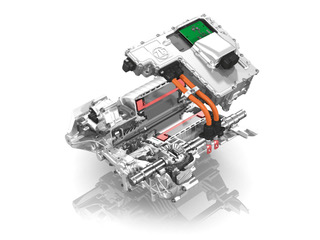
Power electronics
In electric and hybrid vehicles, the power electronics control the electric drive and provide the connection between the electric motor and the high-voltage battery. They also convert the direct current (DC) for the electric motor provided by the battery into high-voltage alternating current (AC) voltage.
Function
The power electronics from electric and hybrid vehicles consist of an inverter and a voltage converter. The inverter controls and monitors the electric motor and provides the necessary torque supply and speed control for the electric driveline. The inverter also converts the DC voltage of the battery into the AC voltage required by the electric motor. Optionally, the low-voltage vehicle electrical system can be supplied with power from the high-voltage vehicle electrical system by means of an integrated voltage converter.
The power electronics are a key component in any electrical drive, as they supply power to not only the electric motor, but also the high-voltage battery – when the electric motor operates as an alternator and saves power in the battery. This process is known as recuperation, whereby the power electronics convert the alternating current generated by the electric motor into direct current, which charges the battery.
Another function of the power electronics is that they enable reverse driving by reversing the polarity and, thus, changing the rotational direction of the electric motor.
For functionality reasons, the power electronics are positioned between the high-voltage battery and the electric motor, regardless of where the control unit is installed in the vehicle.
Important criteria to consider when developing power electronics include functionality, efficiency, space requirements, and weight. Many systems are designed as modular and scalable, meaning that they can be used in different development stages in a broad range of vehicles.
To be able to operate electric and hybrid vehicles with especially high efficiency, it is essential to maintain the temperature of not only the electric motor and the battery within an optimum temperature range, but that of the power electronics, as well. To ensure this, you need a powerful thermal management system – one that cools the components and keeps them within the optimum temperature range.








